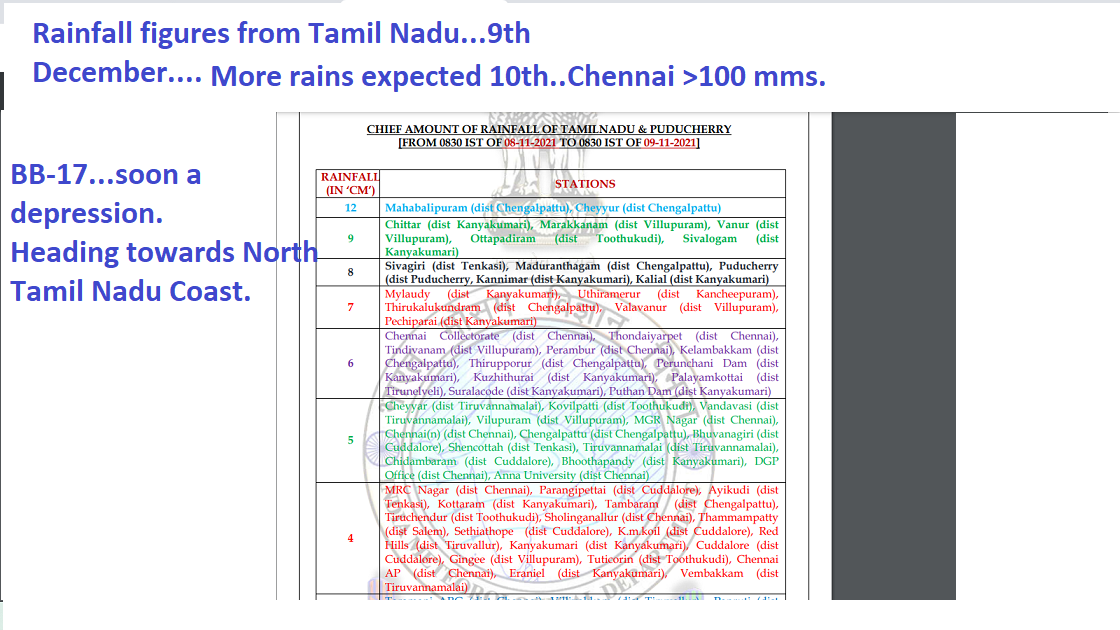Minimum temperatures in Maharashtra on 9/11/2021 in °C:
1. Mahabaleshwar(Nr Venna Lake):9
2. Pabal:11
3. NDA(#Pune):12.1
4. Pune IMD:12.7
5. Gondia & Jalgaon:13
6. Pashan:13.4
7. Rajgurunagar:13.5
8. Akola AWS:13.9
9. Daund:13.8
10. Aurangabad:13.6
11. Nashik:13.4
12. Talegaon & Washim:14
13. Beed:14.2
14. Nagpur:14.4
15. Yeola:14.5
16. Parbhani:14.8
17. Lohegaon (Pune) & Solapur:15
18. Gadchiroli:15.4
19. Buldhana:15.6
20. Nanded:15.9
21. Osmanabad:16
22. Satara:16.1
23. Sangli:17
24. Lavale:17.9
25. Kolhapur:18.5
Compiled by: Vagarian Abhishek Apte





1 comment:
Credit Australian Government Bureau of metereology latest issued 09 11 2021
Issued 9 November 2021
The latest Climate Driver Update and Climate Model Summary are now available on the Bureau's website.
Negative IOD weakens, La Niña ALERT continues
ENSO Outlook
Our ENSO Outlook provides
up-to-date information on the likelihood of an El Niño or La Niña developing.
ENSO Outlook dial showing La Niña ALERT status
Current status: La Niña ALERT
The Bureau's ENSO Outlook remains at La Niña ALERT, meaning around a 70% chance of La Niña forming in the coming months. Several climate drivers are combining to produce the current wet outlook for Australia.
International climate models have strengthened their forecast likelihood of La Niña forming before the end of the year. However, atmospheric and oceanic observations have yet to consistently reach La Niña levels. The latest tropical Pacific Ocean temperatures, while cooler than average, are at similar levels to a fortnight ago and do not meet La Niña thresholds. Similarly, in the atmosphere, the Southern Oscillation Index (SOI) has eased back slightly from La Niña levels. Regardless of whether La Niña thresholds are met, a La Niña-like pattern in the Pacific may still increase the chances of above-average rainfall for northern and eastern Australia at times during spring and summer.
The negative Indian Ocean Dipole (IOD) has weakened, with the weekly index rising to neutral values. However, cloud patterns in the eastern Indian Ocean suggest the atmosphere is still responding to warmer than average ocean temperatures in the region. All models indicate the IOD will remain neutral for the coming months, typical of its annual cycle. A negative IOD increases the chances of above-average spring rainfall for much of southern and eastern Australia.
The Madden–Julian Oscillation (MJO) is forecast by a minority of climate models to strengthen and move eastwards across the Maritime Continent and into the western Pacific over the coming fortnight. If the MJO strengthens this would increase chances of above average rainfall across north-east Australia.
The Southern Annular Mode (SAM) has been positive for the past three weeks, and is forecast to remain at positive levels to the end of the year. A positive SAM during summer typically brings wetter weather to eastern parts of Australia, but drier than average conditions for western Tasmania.
Climate change continues to influence Australian and global climate. Australia's climate has warmed by around 1.44 °C for the 1910–2019 period. Rainfall across northern Australia during its wet season (October–April) has increased since the late 1990s. In recent decades there has been a trend towards a greater proportion of rainfall from high intensity short duration rainfall events, especially across northern Australia.
More information
Media enquiries: (03) 9669 4057 media@bom.gov.au
Next update expected on 23 November 2021
Post a Comment